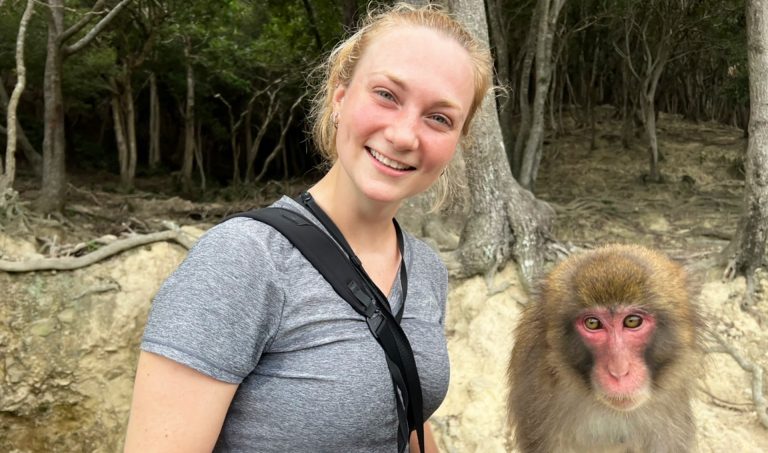Concordia Public Scholar Brogan Stewart decodes subtle signals in Japanese macaque behaviour

From Japan to Chicago’s Lincoln Park Zoo, Concordia Public Scholar Brogan Stewart, BSc 18, MSc 19, has travelled far and wide for her research. The doctoral candidate in environmental science has been following the trail of wild and captive Japanese macaque monkeys since 2019.
As part of her research, Stewart is examining macaque behaviour to better understand how their environmental context affects stress levels. She is also observing the behaviour of monkeys born with disabilities to determine whether they are stressed later in life.
Stewart, an animal lover and climate activist, is a founding member of the Climate Emergency Committee, a group of Concordia undergrads, graduate students and professors who come together to take action on the global climate emergency.
Stewart’s research is funded by the Natural Sciences and Engineering Research Council of Canada (NSERC), Fonds de recherche du Québec – Nature et technologies (FRQNT), Quebec Centre for Biodiversity Science and Concordia.
‘I have to get to know certain monkeys really well’
What are you hoping to achieve through your research?
Brogan Stewart: The goal of my research is to determine whether a monkey is stressed by its environment so that appropriate changes can be made before they begin to exhibit signs of severe stress. If you’ve ever been to a zoo and seen a polar bear swinging its head back and forth, it’s a sign it’s stressed within its environment. It probably needs a bigger habitat and more complexity within that habitat to stimulate it.
We start seeing less complex, repetitive behaviours with primates when they’re stressed too. Monkeys groom themselves by picking lice and bugs out of their fur, but they’ll overdo it to the point where they’re losing hair from it. My research is trying to find a link between those stereotypic behaviours and the environment.
I’m looking at subtle changes in the behaviour of five groups of Japanese macaques: a wild group, a free-ranging group and three captive groups. The wild and free-ranging groups represent the ideal behaviour. For the three captive groups, I’m going to look at the environment and see whether they have three-dimensional space for climbing, access to cognitive enrichment, vegetation, etcetera. I’m going to see if I can find a decrease in the complexity of their behaviour when their environment is less complex.
How do you measure the complexity of monkey behaviour?
BS: I’m using a type of analysis called fractal analysis. If you picture a fern leaf, for instance, the leaf is the exact replicate of the smaller leaflets coming out of the stem, and the smaller leaflets on each leaflet are a smaller repeating pattern of that bigger leaflet. You have a self-repeating pattern at different scales. Those are fractal structures and they are all over nature.
 Ferns exhibit fractal features. The entire fern is mostly built up from the same basic shape repeated at ever-smaller scales.
Ferns exhibit fractal features. The entire fern is mostly built up from the same basic shape repeated at ever-smaller scales.
The theory is that animal behaviour in time also has a fractal structure. Just like you can quantify the complexity of fractal structures in nature, you can quantify the complexity of animal behaviour in the time series data. The thinking is that there’s an optimal range of complexity that animals fall in when they’re healthy and they can go above it or below it when they’re stressed. Their behaviour could become more periodic, like animals in zoos, or it could become random and frantic.
How do you collect data on monkey behaviour?
BS: I have to get to know certain monkeys really well. There were around 500 monkeys in total in one group in Japan, but in my study I only looked at about 20. I had to tell those 20 monkeys apart from the others every day. You really get to know them and spend weeks watching them.
I would do what you call a focal sample. Each is 35 minutes long. You record the monkey in question during that period and note down all the behaviours they perform: “scratch, walk, jump, walk.” You get to see all their little intricacies and get to know their personalities. Some of them were more timid and gentle, while others were really hyper, strutting around.
Learn more about Concordia’s Public Scholar Program.


